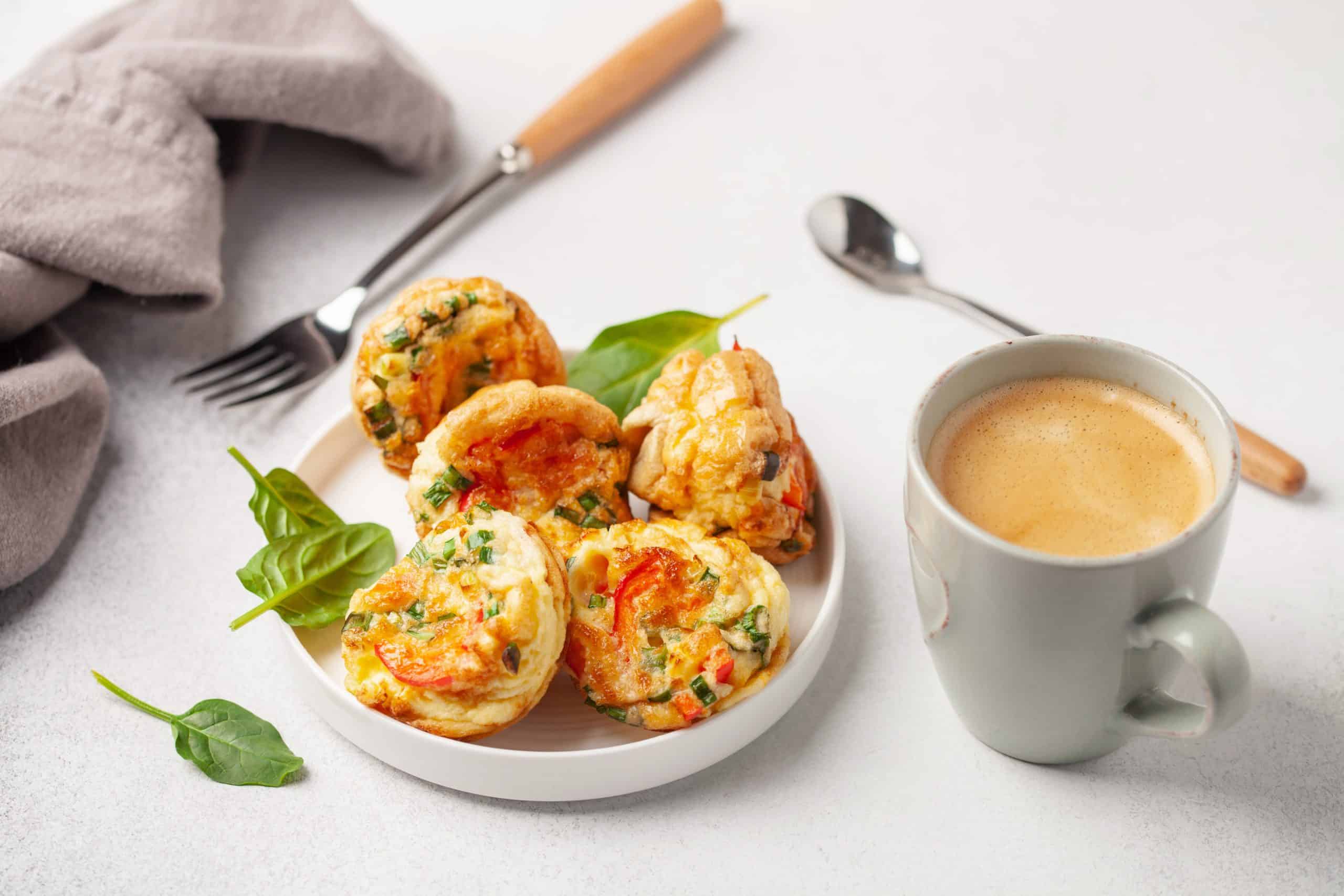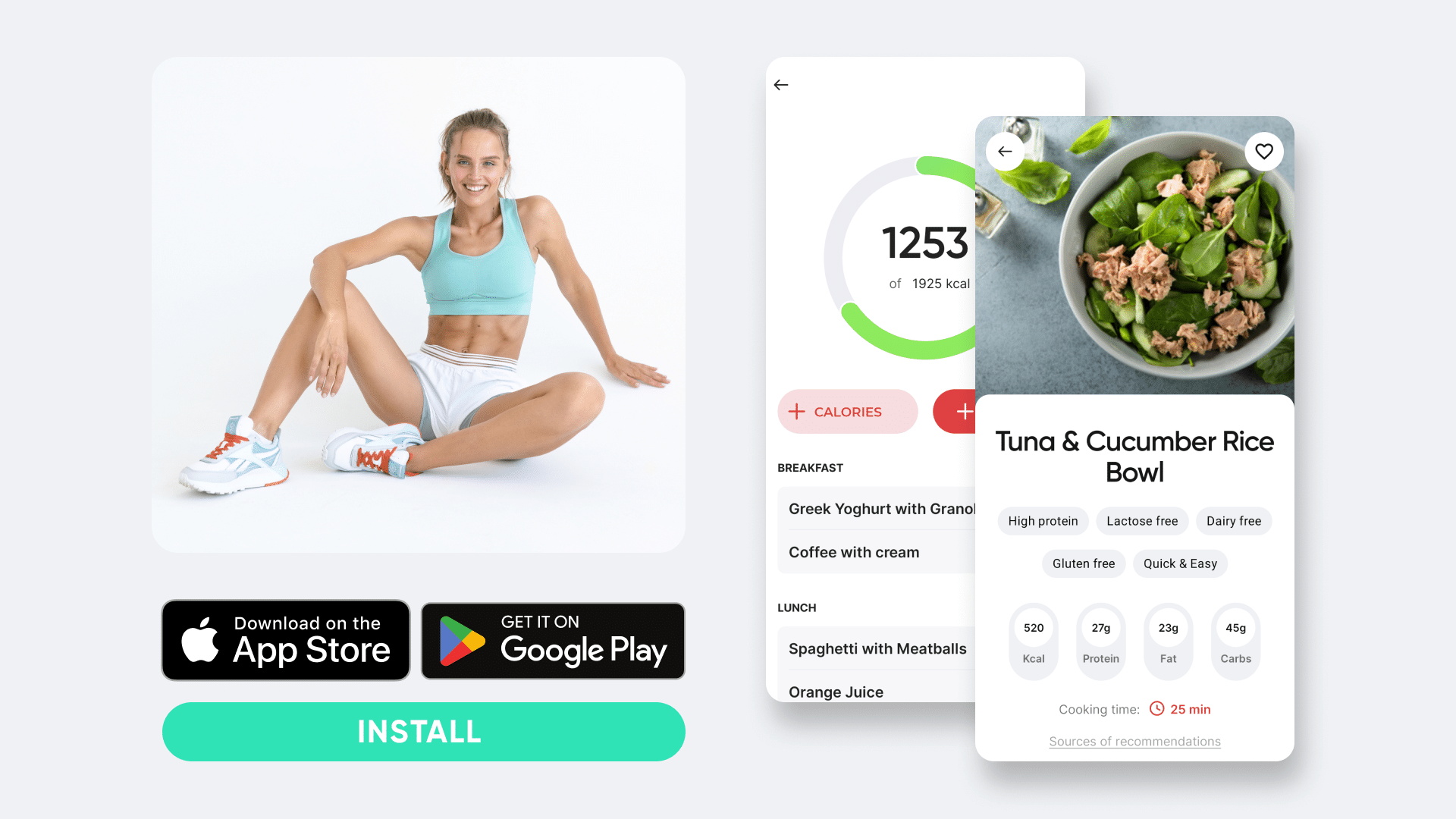Protein is an essential macronutrient for a healthy life. The Dietary Guidelines for Americans 2020–2025, advises that an adult male should consume at least 56 grams (g) of protein while an adult female should get at least 46 g daily (1).
According to research, eating enough protein from the right source helps prevent chronic illnesses like diabetes, heart disease, cancer and premature death and also promotes hormone production, good gut health, bone health, prevents loss of muscle mass and helps with the management of obesity (2, 3).
For someone who is looking to achieve a healthy weight, protein can play a huge role in weight loss and management. Low calorie foods also play a big part in a weight loss diet as they allow you to consume satisfying amounts of food without going over your recommended calorie deficit.
In this article, we shall be looking at some low calorie high protein foods for weight loss that you can add to your diet to help you achieve your goals.
What Are Low-Calorie High Protein Foods For Weight Loss?
The name describes exactly what these foods are. These are foods that provide a lot of protein in a single serving, without necessarily offering a ton of calories per the same serving amount.
Research strongly suggests that when it comes to weight loss, your calorie deficit matters much more than the specific diet you are on (4). Simply meaning that as long as you burn more calories than you take in (by eating), then it doesn’t matter what new age or ancient diet you try, or if you just eat a healthy, balanced, regular diet – you are likely to lose weight..
With this in mind, including low calorie high protein foods can help you stay within the recommended calorie deficit intake, which will make your weight loss diet that much easier.
Can You Really Lose Weight On A High Protein Low Calorie Diet?
Yes, you can – if it works for you. Any diet that helps you create a calorie deficit and that you can stick to long-term can help you lose weight. Research has highlighted some potential advantages of high protein diets for weight loss. Some of these studies are as follows:
2015
A review published in The American Journal of Clinical Nutrition suggested that higher-protein diets are a successful strategy to prevent or treat obesity through improvements in body weight management (5).
The researchers stated that when compared to low protein diets, higher protein diets showed better results in regards to weight loss, fat mass loss, preservation of lean mass, and reduction of waist circumference.
This review also found that this macronutrient helps promote satiety and perceived fullness. Researchers suggested that for weight loss, one might consider targeting anywhere from 1.2 g to 1.6 g of protein per kg of body weight per day or at least 25–30 g of protein per meal (5).
2018
Another review published in Nutrients suggested that not only is protein satiating, it also plays a huge role in the growth, maintenance and preservation of muscle mass and strength (6).
For those who may not know, having more muscle in the body helps with weight loss as muscle helps the body burn more calories while at rest. In the study, the researchers also echoed the statements made in the study above by stating that protein helps to reduce hunger and promote satiety which can help with weight management.
Protein also increases diet-induced thermogenesis, meaning that you burn more calories when digesting protein than when digesting either fats or carbohydrates. This temporary modest increase in metabolic rate helps with calorie burning, which over time might mean more weight loss.
This specific study also places great importance on plant-based protein which means that when making your list of top 10 protein foods, you should not hesitate to add plant protein sources as an alternative to animal based sources.
Examples of these high protein vegan foods include beans, pulses and other legumes. Nuts, seeds, and soy-based products like tofu also make for fantastic plant-based sources of this macronutrient (6).
The BetterMe: Health Coaching app will provide you with a host of fat-frying fitness routines that’ll scare the extra pounds away and turn your body into a masterpiece! Get your life moving in the right direction with BetterMe!
2020
Another review published in the Journal of Obesity & Metabolic Syndrome also concluded that high protein diets are an effective and safe tool for weight reduction that can prevent obesity and obesity-related diseases (7).
Researchers stated that this diet helps to not only reduce body weight, but also to enhance body composition by decreasing fat mass while preserving fat-free mass. According to the review findings, protein does this by (7)
- Increasing satiety hormone levels (such as leptin) while decreasing hunger hormone levels (such as ghrelin), resulting in increased overall satiety signaling and, eventually, reduced food intake
- Elevating diet-induced thermogenesis which helps with increased calorie burning.
- Providing the building blocks for muscle protein, which helps prevent a decrease in lean body mass, which in turn helps maintain resting energy expenditure in spite of weight loss.
2021
A review looking at the optimal diets for weight loss suggested that diets higher in protein contribute to weight loss through their satiating effect, which helps decrease energy intake and maintain successful weight loss (4).
The study also supported claims made by all the listed studies above by stating that:
- This macronutrient has the highest diet-induced thermogenesis which contributes to higher energy expenditure during nutrient processing.
- Protein helps to preserve lean body mass during weight loss. The more lean mass in the body, the more calories you burn while at rest.
The study also warns that high intakes of protein and fat may increase the risk of type 2 diabetes. They also point out that high protein intake from red meat may increase the risk of chronic kidney disease. They suggest that protein from plant sources, low-fat dairy, and seafood are healthier choices (4).
How Can I Get High Protein Without Calories?
There are no high protein foods that are zero calories. Protein itself provides calories, so that would be impossible. However, there are definitely a number of foods that will give you the desired high protein content but with a reasonably low calorie count.
Read more: 7 Day High Protein Meal Plan for Weight Loss and Muscle Gain
What Food Is High In Protein But Low In Calories?
Some of these foods are as follows
Eggs
If you are looking for low calorie high protein snacks, look no further than eggs.
Eggs are a powerhouse that is not only high in protein but they also contain nutrients like B vitamins, vitamin D, choline, selenium and iron. More recent research also suggests that they do not increase the risk of cardiovascular disease as previously thought (8)
Please note that eggs make good low calorie high protein foods for vegetarians – specifically lacto-ovo and pesco-vegetarians. Two large eggs offer 12 g of high quality protein and about 150 calories (9)
Greek Yogurt
Studies on the effect of Greek yogurt on the body, specifically when combined with resistance training, suggest that it can help with reduced body fat, as well as increased muscle strength, muscle thickness and bone formation, at least in comparison to a carbohydrate-based placebo (10, 11).
100 g of nonfat Greek Yogurt has about 10 g of protein and about 60 calories. When making a 7-day protein diet plan for weight loss, Greek yogurt can be used as a high protein substitute for mayo, in curries as a thickener, or in place of sour cream in recipes.
Fish and Shellfish
Both finfish and shellfish are great sources of protein and healthy fats, while being low in calories.
Fish and shellfish are also good for brain health, heart health, can aid in weight loss and are also fantastic for your immune system since they contain a number of micronutrients like iron, zinc, magnesium, Vitamin B12 copper, inorganic phosphate, sodium, potassium, selenium, and iodine among others (12, 13, 14).
Common examples of shellfish include shrimp, lobsters, oysters, mussels, scallops, clams, crabs, krill, crayfish, squid, cuttlefish, snails, and abalone. Fish include salmon, tuna, cod, halibut, tilapia, and many more.
Cooked shrimp contains 24 g of protein and 99 calories per 100 g lobster has 19 g of protein and about 90 calories per 100 g, and oysters have 9 g of protein and 200 calories per 100 g (15, 16, 17). Salmon has 20 grams of protein and about 200 calories per 100 grams, while cod contains about 18 grams of protein and 83 calories per 100 grams.
Poultry Meats
Poultry and especially chicken meat is often used as a substitute for red meat largely because unlike the latter, it has less fat content. This depends on the cut and whether or not the skin is eaten. Skinless chicken is generally low in fat with low sodium and cholesterol levels.
Not only is poultry meat lower in calories than red meat, it also has highly digestible good quality proteins, B-group vitamins, and minerals. All these factors mean that poultry meat is supportive of your immune system and overall health (18, 19, 20).
100 g of boneless, skinless chicken thigh has 18.6 g of protein and 73 calories while the same quantity of boneless, skinless chicken breast contains 22.5 g of protein and 75 calories (21, 22). Because of the lower fat content in poultry meat, specifically chicken breast, poultry makes one of the best high protein, low fat foods for muscle building.
Plant Protein
For those who do not consume animal products and for anyone who wishes to have alternate sources of protein, plant protein is a fantastic option. It is generally recommended that we all include more plant-based protein sources in our diets, even if we do eat meat as well. Plant protein sources include:
- Beans, lentils, and other pulses
- Nuts and seeds including almonds, peanuts and peanut butter, as well as pumpkin, sunflower, chia and hemp seeds. These can be a little higher in calories due to their healthy fat content, so be mindful of the recommended portion sizes.
- Soy products like tofu and edamame
- High protein non starchy vegetables like broccoli, cauliflower, greens, peppers, asparagus, and mushrooms
Soy products and especially tofu, plus non starchy vegetables may make a great base for any quick low calorie lunch recipes for weight loss.
BetterMe is your fast-track ticket to long-lasting weight loss! Tailor your fitness journey and maximize your results with just a couple of swipes!
Lean Meat
Red meat is best limited for overall health, but it can be included in moderation in a healthy diet, especially if it is lean. Options like pork loin and lean beef or minced beef make good low calorie high protein foods for weight loss. In fact, they are top among the highest protein foods per 100 g alongside options like salmon and chicken breast.
- 100 g of ground 90% lean meat / 10% fat has 18.2 g of protein and about 190 calories (23)
- Boneless pork tenderloin has 21.6 g of protein and about 125 calories per 100 g (24)
- 100 g of lean steak stripes contain 23.1 g of protein and 117 calories (25)
What Foods Are High In Protein And Good For Weight Loss?
All the foods listed in the section above are high in protein and incredible for weight loss. They include plant-based sources like beans, tofu, and nuts. They also include eggs, dairy, seafood, poultry, and lean meats.
What Protein Is Best For Losing Weight?
All protein sources are great for losing weight, especially if they are not too high in calories. Common protein sources like eggs, lean beef, dairy, fish and chicken are already good proteins that can help with weight loss. It is also a good idea for everyone to increase their intake of plant-based protein sources, like beans, lentils, tofu, and others.
Protein powder – made from either whey or plant-based sources also makes a quick protein source for whenever you don’t want to cook but want a simple high protein snack. You can also cook with protein powder, especially in baking to up the protein content in your final product.
Read more: 10 High Protein Fruits You Can Add to Your Diet
FAQs
What Food Is Highest In Protein?
Animal based foods like meats, eggs, and milk are usually higher in this macronutrient as compared to plant-based sources, but there are some great plant-based protein sources as well, like beans, lentils, tofu, and others.
What Are 0 Calorie Foods For Fasting?
Despite the term zero calorie foods trending, there is no food that absolutely has no calories. Some may be super low in calorie content, but the number will never be zero.
Will 1 Calorie Break A Fast?
1 calorie will probably not break your fast. Even black coffee, which is considered “zero” calorie for fasting purposes, actually has a few calories (about 2 per 8-ounce serving). This is considered negligible and so not enough to break your fast, which is why black coffee is allowed during fasting.
What Not To Eat After A 16-Hour Fast?
It may be advisable not to break your fast with foods that are high in fat, sugar, or even fiber. This is because the stomach has gone for a long period without food, which means that some people find these options harder to digest and can lead to bloating and discomfort. Instead opt for things like smoothies, eggs, or a soup.
The Bottom Line
We hope that the above listed low-calorie high-protein foods for weight loss gives you an idea of what to shop for the next time you go grocery shopping. Remember that while protein is great for weight loss, it does not do the job by itself. Fill your diet with complex carbs, healthy fats, dark leafy greens and a lot of non-starchy vegetables. Above all, if you’re trying to lose weight, remember to eat on a calorie deficit.
DISCLAIMER:
This article is intended for general informational purposes only and does not serve to address individual circumstances. It is not a substitute for professional advice or help and should not be relied on for making any kind of decision-making. Any action taken as a direct or indirect result of the information in this article is entirely at your own risk and is your sole responsibility.
BetterMe, its content staff, and its medical advisors accept no responsibility for inaccuracies, errors, misstatements, inconsistencies, or omissions and specifically disclaim any liability, loss or risk, personal, professional or otherwise, which may be incurred as a consequence, directly or indirectly, of the use and/or application of any content.
You should always seek the advice of your physician or other qualified health provider with any questions you may have regarding a medical condition or your specific situation. Never disregard professional medical advice or delay seeking it because of BetterMe content. If you suspect or think you may have a medical emergency, call your doctor.
SOURCES
- Dietary Guidelines for Americans 2020–2025 (n.d., dietaryguidelines.gov)
- Health Benefits of Dietary Protein throughout the Life Cycle (2020, researchgate.net)
- Protein (n.d., nutritionsource.hsph.harvard.edu)
- Optimal Diet Strategies for Weight Loss and Weight Loss Maintenance (2021, ncbi.nlm.nih.gov)
- The role of protein in weight loss and maintenance234 (2016, ajcn.nutrition.org)
- Protein for Life: Review of Optimal Protein Intake, Sustainable Dietary Sources and the Effect on Appetite in Ageing Adults (2018, ncbi.nlm.nih.gov)
- Clinical Evidence and Mechanisms of High-Protein Diet-Induced Weight Loss (2020, ncbi.nlm.nih.gov)
- Eggs: Healthy or Risky? A Review of Evidence from High Quality Studies on Hen’s Eggs (2023, ncbi.nlm.nih.gov)
- Eggs, Grade A, Large, egg whole (2019, fdc.nal.usda.gov)
- Greek Yogurt and 12 Weeks of Exercise Training on Strength, Muscle Thickness and Body Composition in Lean, Untrained, University-Aged Males (2019, ncbi.nlm.nih.gov)
- Exploring the Effects of Greek Yogurt Supplementation and Exercise Training on Serum Lithium and Its Relationship With Musculoskeletal Outcomes in Men (2021, ncbi.nlm.nih.gov)
- Shellfish: Nutritive Value, Health Benefits, and Consumer Safety (2017, ift.onlinelibrary.wiley.com)
- The Effects of Shellfish Consumption Frequency for Human Health (2021, researchgate.net)
- Shellfish consumption and health: A comprehensive review of human studies and recommendations for enhanced public policy (2022, pubmed.ncbi.nlm.nih.gov)
- Crustaceans, shrimp, raw (2019, fdc.nal.usda.gov)
- Crustaceans, lobster, northern, raw (2019, fdc.nal.usda.gov)
- Mollusks, oyster, Pacific, raw (2019, fdc.nal.usda.gov)
- The role of poultry in human nutrition (n.d., fao.org)
- Role of poultry meat in a balanced diet aimed at maintaining health and wellbeing: an Italian consensus document (2015, ncbi.nlm.nih.gov)
- Nutritional and health-promoting aspects of poultry meat and its processed products (2013, tandfonline.com)
- Chicken, thigh, boneless, skinless, raw (2023, fdc.nal.usda.gov)
- Chicken, breast, boneless, skinless, raw (2023, fdc.nal.usda.gov)
- Beef, ground, 90% lean meat / 10% fat, raw (2023, fdc.nal.usda.gov)
- Pork, loin, tenderloin, boneless, raw (2023, fdc.nal.usda.gov)
- Beef, grass-fed, strip steaks, lean only, raw (2019, fdc.nal.usda.gov)










